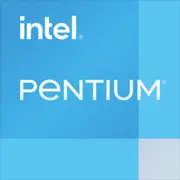Intel Pentium G4560

Intel Pentium G4560: Budget Processor of 2025 - Is It Worth It?
Key Characteristics: Architecture and Performance
The Intel Pentium G4560, released in 2017, belongs to the Kaby Lake generation (7th Core generation). Despite its age, it remains relevant in the budget segment due to its unique features.
Manufacturing Process: 14 nm - an outdated technology by 2025, but still provides low power consumption (TDP 54W).
Cores and Threads: 2 cores / 4 threads (Hyper-Threading) - a key advantage over dual-threaded Celeron processors.
Cache: 3 MB L3 - the minimum for basic tasks.
Graphics: Intel HD 610 - suitable for display output but not for gaming.
Performance: In the Geekbench 6 test (2025) - 706 (single-thread) and 1451 (multi-thread). This is sufficient for office applications, browsing, and 1080p video.
Key Features:
- Support for DDR4-2400 - fast memory for its time.
- Hyper-Threading - multi-threading for parallel tasks.
- Compatibility with Windows 10/11 and Linux - up-to-date operating systems.
Compatible Motherboards: Socket and Chipsets
Socket: LGA 1151 - an outdated socket, new motherboards for it are not being produced. In 2025, look for boards on the secondary market:
- H110: Budget option (starting from $40), but requires a BIOS update for Kaby Lake.
- B250: Optimal choice (used - $50-70) - supports USB 3.1, M.2 (SATA).
- H270/Z270: Premium segment (rare, $80+) but excessive for Pentium.
Important: When purchasing a new (unused) motherboard, check the BIOS version - some require an update to work with the G4560.
Supported Memory: DDR4 vs DDR5
The processor works only with DDR4-2400 and DDR3L-1600. DDR5 and modern standards are not supported.
Recommendations:
- 8 GB DDR4-2400 (new modules - $30) - the minimum for Windows 11.
- 16 GB DDR4-2400 ($55) - a buffer for a browser with 50+ tabs.
Limitations: On boards with DDR3L (like H110), use only low-voltage memory (1.35V).
Power Supply: Power Calculation
With a TDP of 54W, even a budget power supply will be sufficient:
- Without a graphics card: 300W (e.g., EVGA 300 BR, $40).
- With a graphics card: 400-500W (Be Quiet! System Power 10 450W, $55). Consider GPU power needs - for example, for a GTX 1650 (75W), 400W is sufficient.
Tip: Do not skimp on the power supply - cheap models can damage components. Look for an 80 Plus Bronze certification.
Pros and Cons of Pentium G4560
Pros:
- Price: New processors - $50-60 (2025).
- Energy Efficiency: Suitable for mini-PCs and HTPCs.
- Hyper-Threading: Better multitasking than dual-threaded CPUs.
Cons:
- 2 cores: Multi-threaded applications (Photoshop, Blender) can lag.
- Weak graphics: A discrete graphics card is required for gaming.
- Outdated platform: No upgrade path to new CPUs without replacing the motherboard.
Use Cases: Where the Potential Shines
1. Office and Study: Word, Excel, Zoom - the processor handles tasks without lag.
2. Home Media Center: 4K video through HDMI 1.4 (limited to 30Hz).
3. Light Gaming: CS:GO (60 FPS on low settings), Minecraft.
4. Servers: NAS or Linux-based router (low power consumption).
User Experiences:
- A build with GTX 1050 Ti ($150) and 8 GB DDR4 runs GTA V on medium settings (45-50 FPS).
- With an SSD, the system boots in 10-12 seconds.
Comparison with Competitors
1. AMD Athlon 3000G (2 cores / 4 threads, Vega 3):
- Pros: Better graphics, support for DDR4-2666.
- Cons: Lower single-thread performance (Geekbench 6 Single Core - ~650).
- Price: $60 (new).
2. Intel Celeron G5905 (2 cores / 2 threads, UHD 610):
- Pros: Newer (2020), higher clock speed.
- Cons: No Hyper-Threading - worse multitasking.
- Price: $45.
3. Ryzen 3 1200 (4 cores / 4 threads, no integrated graphics):
- Pros: 4 cores for multi-threaded tasks.
- Cons: Requires a graphics card, more expensive ($70).
Conclusion: The G4560 outperforms Celeron and Athlon in price-to-multithreading balance.
Practical Assembly Tips
1. Motherboard: ASRock B250M-HDV ($70 new) - 4 SATA slots, M.2.
2. Storage: 240 GB SSD (Kingston A400, $25) - speeds up the system.
3. Memory: 8 GB Patriot Signature DDR4-2400 ($30).
4. Case: Mini-Tower (Deepcool MATREXX 30, $35) for a compact build.
5. Cooling: Stock cooler is sufficient - noise level around 35 dB.
Life Hack: If you plan to upgrade, get a motherboard with PCIe 3.0 x16 for a future graphics card.
Final Conclusion: Who Should Consider the Pentium G4560?
This processor is suitable for:
- Budget Users: Building a PC for $200-300.
- Office Workers: Reliability and adequate performance.
- Retro PC Enthusiasts: Creating systems on older chipsets.
Why in 2025? Despite its age, the G4560 remains one of the most affordable CPUs with Hyper-Threading. However, for gaming or video editing, it’s better to add $50-70 and opt for the Ryzen 3 4100 (4 cores / 8 threads).
Price/Quality: 8/10 - ideal for tasks where every $10 counts.
Basic
CPU Specifications
Memory Specifications
GPU Specifications
Miscellaneous
Benchmarks
Compared to Other CPU
Share in social media
Or Link To Us
<a href="https://cputronic.com/cpu/intel-pentium-g4560" target="_blank">Intel Pentium G4560</a>